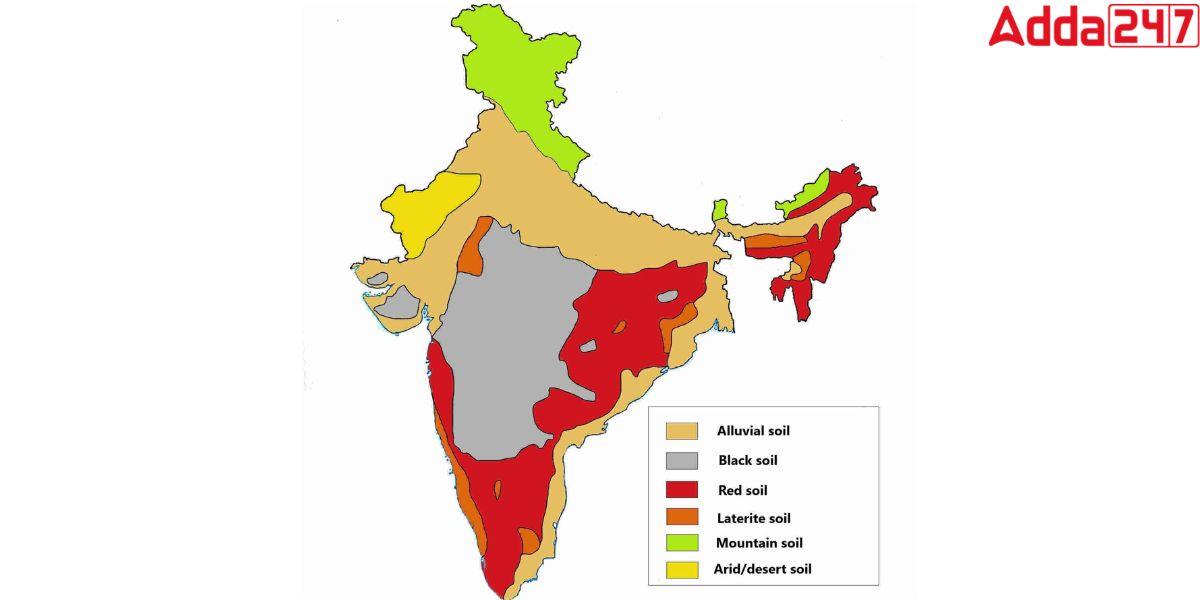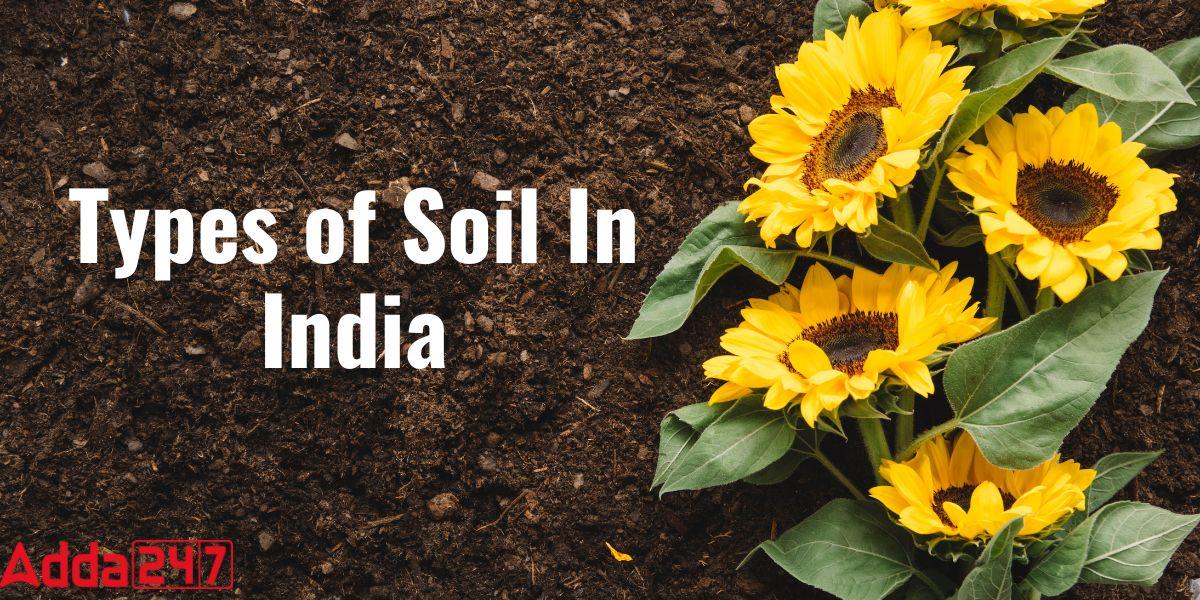Types of Soil in India
The major type of soil in India are laterite soil, alluvial soil, black soil, peaty soil, red soil, black soil, mountain soil, desert soil, saline and alkaline soil. Soil is defined as the organic and inorganic materials on the earth’s surface that provide a medium for plant growth. Soil evolves slowly over time and is made of various materials. Weathered rocks and minerals are examples of inorganic materials or nonliving materials. Weathering is the mechanical or chemical process that breaks down rocks into smaller pieces. When rocks are broken down, they mix with organic materials, which are those derived from living organisms. Plants and animals, for example, die and decompose, releasing nutrients back into the soil.
How Many Types of Soil in India?
There are 10 types of major soil found in India
- Alluvial soil
- Red soil
- Black / regur soil
- Arid/desert soil
- Laterite soil
- Saline soil
- Peaty/marshy soil
- Forest soil
- Sub-mountain soil
- Snowfields
Major Soil Types in India Map
See Map of Major Types in India. which is given below.

Major Soil Types in India Class 10
Now, learn about different major types of soil in India in detail.
Alluvial soil
In India, the soil is mostly alluvial (about 43%) and covers an area of 143 square kilometres. It is common in the northern plains and river valleys. They are mostly found in deltas and estuaries in peninsular India.There is hummus, lime, and organic matter present. This soil is extremely fertile.Khadar refers to new alluvium, while Bhangar refers to old alluvium. The soil is Light grey to ash grey in colour.
Examples include the Indus-Ganga-Brahmaputra plain, the Narmada-Tapi plain, and others.
Red soil
\This soil is commonly observed in low-rainfall areas. This soil is also referred to as the Omnibus group.Red soil is Structured with pores and friability. Because of the presence of ferric oxide, the colour is red, the lower layer is yellow or reddish yellow. Wheat, cotton, pulses, tobacco, oilseeds, potatoes, and other crops are grown in red soil.
Black soil/Regur soil
The word Regur means cotton, and the best soil for cotton production is black or regur soil. The majority of the Deccan is covered in black soil. This soil has a high capacity for water retention. Self-ploughing is a feature of black soil, which develops wide cracks when dried. The colour of black soil ranges from deep black to light black and is rich in iron, lime, calcium, potassium, aluminium, and magnesium.
Arid and desert soil
This soil is found in arid and semi-arid environments and is deposited primarily as a result of wind activity Contains a lot of salt. This soil is deficient in moisture and humus. Kankar is abundant in this soil. The soil is red to brown in colour.
Laterite soil
Laterite is a Latin word that means “brick.” This soil is soft when wet and hard when dry. Laterite soil is found in areas with high temperatures and rainfall, and it is formed as a result of heavy leaching. One of the important characteristics of this soil is that the humus is low because the organic matter in the soil is quickly removed by bacteria due to the high temperature, and the hummus is quickly taken up by trees. Another Laterite is rich in Iron and Aluminium. The colour of the soil is red due to iron oxide. Rice, ragi, sugarcane, and cashew nuts are the most commonly grown crops.
Saline soil
Usara soils are another name for saline soil. Local names for saline soils include Reh, Kallar, and Chopan, Rakar, Thur, Karl, and so on. These soils developed in areas with dry climatic conditions (with slightly more rainfall than desert soils) and a lack of proper drainage. Capillary action deposits sodium, calcium, and magnesium salts on the upper layer of the soil in this condition. In the Rann of Kuchchh, the Southwest Monsoon brings salt particles and deposits them as a crust. These soils are also formed when saline water spreads on the land during high tide in coastal areas. In addition, seawater intrusions in deltas promote the formation of saline soils.
Marshy soil is found in areas with a lot of rain and humidity. Vegetation growth is very slow here. This soil contains a lot of dead organic matter/humus, which makes it alkaline. This is black soil with a heavy texture.
Sub-mountain soil
This soil is low in humus and acidic. Mountain soils are most common in the Himalayan regions, Sikkim, Assam, Arunachal Pradesh, and Kashmir, as well as the Peninsula, Eastern Ghats, and Sahyadris summits
Types of Soil in India for Agriculture
India is an agriculture-based country where the soil is its most valuable resource. India’s economy depends heavily on it because most of our sectors are agro-based. The country’s overall population depends on agriculture to the tune of 65 to 70 per cent. In general, India has six different soils.
Black soil or Regur Alluvial Soil.Red soil, Desert Soil Laterite Soil, and Montane Soil.
The fertility of the soil determined whether it was classified as fertile or non-fertile. Today, several features can be used to categorise different types of soil based on its texture, moisture content, colour, ability to hold water, etc. On based the components present in each soil, the fertility also differs from each other. According to the fertility of the soil, here is a list of crops which are harvested on the different soils in India,
| Types of Soil | Crops Harvested |
| Alluvial Soil | Rice, wheat, jute, oilseeds, sugarcane, tobacco, maize, cotton, soybean, etc. |
| Laterite Soil | Coconut, Banana, yams, pepper, pineapple, vegetables, |
| Black soil | Cotton, Jowar, Wheat, Linseed, Gram, |
| Red | Wheat, Rice, Millet, Pulses. |
Types of Soil in India with States Classification
Here is the list distribution of different types of Soil in India.
| Types of Soil | Distribution |
| Alluvial Soil | Alluvial soils are common in northern India’s plains and river valleys. They cover an area of 15 lakh km² or 40% of India’s total land area. They are formed from the sediments of the Indo-Gangetic rivers. |
| Black soil | The majority of the Deccan plateau is covered in black soil, resulting from the weathering of Basaltic rock formed by the solidification of lava. It can be found primarily in Maharashtra, Madhya Pradesh, Gujarat, Andhra Pradesh, and parts of Tamil Nadu. |
| Laterite soil | They cover 2.5 lakh square kilometres of India’s total land area. Geographically, they can be found in Orissa’s Eastern Ghats, Rajmahal Hills, Vindhyas, Satpura, and some parts of the Western Ghats. |
| Red soil | They form primarily on crystalline igneous rocks in low-rainfall areas. For example, the eastern and southern parts of the Deccan plateau. They are mostly found in Orrisa and Chhattisgarh, as well as some southern parts of the middle Ganga plains |
| Aried Soil | The salt concentration on these soils is high in some areas of Rajasthan. Rajasthan has the highest concentration of arid soil in the world. However, these types of soil can be found in small patches in Punjab, Haryana, and Gujarat. |
| Saline soil | Geographically, they are found in Western Gujarat, the deltas of the eastern coasts, and the Sunderbans of West Bengal. Because of intensive cultivation, the alluvial regions of the Green Revolution are becoming saline.Both intensive irrigation and dry climatic conditions promote capillary action and salt formation in these soils. For example, Punjab and Haryana. |
| Peaty soil | Geographically, they can be found in northern Bihar, southern Uttrakhand, and the coastal areas of West Bengal, Odisha, and Tamil Nadu |
| Forest soil | Brown forest soil, Podzol soil, and Alpine meadow soil are the three structural types.On the valley sides, forest soil is loamy and silty, but coarse-grained on the upper slopes. The Himalayas have a wide range of these soil type |
Classification of Soil Class 10
Soil classification involves categorizing soil into groups based on their physical and chemical properties. The classification systems help in understanding soil behavior under various conditions, which is essential for agricultural, environmental, and construction purposes. Here are the main soil classification systems:
1. Unified Soil Classification System (USCS)
Developed by the U.S. Army Corps of Engineers, this system is widely used in engineering and geology.
- Coarse-grained soils: More than 50% of the soil by weight is larger than 0.075 mm (retained on a No. 200 sieve).
- Gravel (G)
- Well-graded (GW)
- Poorly graded (GP)
- Sand (S)
- Well-graded (SW)
- Poorly graded (SP)
- Gravel (G)
- Fine-grained soils: More than 50% of the soil by weight is smaller than 0.075 mm (passing a No. 200 sieve).
- Silt (M)
- Low plasticity (ML)
- High plasticity (MH)
- Clay (C)
- Low plasticity (CL)
- High plasticity (CH)
- Silt (M)
- Organic soils: Containing significant organic matter.
- Organic silt (OL)
- Organic clay (OH)
- Peat (PT)
2. AASHTO Soil Classification System
Developed by the American Association of State Highway and Transportation Officials, this system is used for road construction.
- Granular Materials: 35% or less passing the No. 200 sieve.
- A-1, A-3
- Silt-Clay Materials: More than 35% passing the No. 200 sieve.
- A-4, A-5, A-6, A-7
3. Soil Taxonomy (USDA)
Developed by the United States Department of Agriculture, this system is used primarily for agricultural purposes.
- Order: The highest level of classification, based on soil formation processes and horizons.
- Examples: Alfisols, Andisols, Aridisols, Entisols, Gelisols, Histosols, Inceptisols, Mollisols, Oxisols, Spodosols, Ultisols, Vertisols
- Suborder: Grouped based on soil moisture and temperature regimes.
- Great Group: More specific characteristics within suborders.
- Subgroup: Modifiers that provide further detail.
- Family: Particle size, mineralogy, temperature.
- Series: The most specific category, often named after geographic locations.
4. FAO Soil Classification (World Reference Base for Soil Resources)
Developed by the Food and Agriculture Organization, it provides a global perspective on soil classification.
- Reference Soil Groups (RSGs): 32 major soil groups.
- Examples: Alisols, Andosols, Arenosols, Calcisols, Chernozems, Ferralsols, Gleysols, Histosols, Kastanozems, Luvisols, Phaeozems, Podzols, Vertisols
5. Engineering Classification of Soil
Primarily used in civil engineering, focusing on properties affecting soil behavior in construction.
- Particle size distribution
- Atterberg limits: Liquid limit, plastic limit, and shrinkage limit.
- Compaction characteristics
- Shear strength
- Permeability
6. British Soil Classification System (BSCS)
Similar to USCS, used in the United Kingdom.
- Coarse soils: Gravels and sands.
- Fine soils: Silts and clays.
- Organic soils: High organic content.
Each classification system serves a different purpose, ranging from agricultural planning to construction and environmental management.









 MGSU Result 2025 Out, Download Maharaja ...
MGSU Result 2025 Out, Download Maharaja ...
 EMS Results 2025 OUT at gnanasangama.kar...
EMS Results 2025 OUT at gnanasangama.kar...
 How to Calculate CUET Score, Check Marks...
How to Calculate CUET Score, Check Marks...









